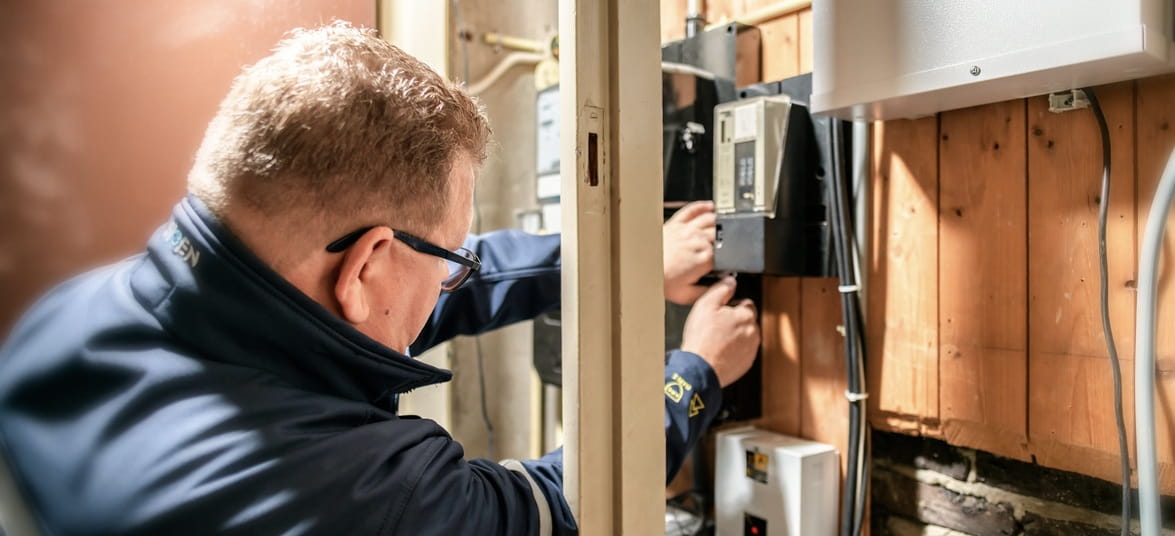Proper earthing in your home

Proper earthing in your home
The type of earthing can differ from one home to another. It depends on the year in which the home was built and how the earthing was installed at the time of construction or following renovation. There are four ways to earth the electrical installation. This can be done via a metal earthing electrode, a water pipe, your network operator or a collective earthing network.
Moisture and metal are good conductors of electricity. Earthed sockets are therefore compulsory in humid rooms, such as bathrooms and kitchens. A bath, shower and other metal elements, such as radiators, are connected to the earthing system. Living rooms and bedrooms, on the other hand, usually have ‘normal’ sockets. Earthing is also recommended for computers and other equipment. In new homes, however, electrical installations will be fully earthed and you will find earthed sockets throughout the home. The reason for this is the increasing amount of metal (electrically conductive) and earthed equipment present in our homes.
Types of earthing
A qualified electrician can help you check the earthing and the type present in your home.
Earthing via metal earthing electrodearding
The earthing conductor of the electrical installation is connected to a metal earthing electrode in the ground. This is connected to the electrical installation in the meter box by means of a metal wire. If an appliance or the installation develops a fault, the electricity is carried away to earth via the electrode.
Earthing via water pipe
In older homes the electrical system may still be earthed via the water pipe. This mainly applies to electrical installations dating from before 1975, although such an earthing system may also be used in the case of more recent installations.
Earthing via the metal water pipe was a simple and perfectly adequate method. However, in many cases it is no longer possible to achieve earthing in this way, as more and more (non-conductive) plastic water pipes are being used.
If a metal water pipe is replaced with a plastic one, you will be informed in good time by your water and/or energy company (unless a fault suddenly develops and the water pipe is replaced immediately during the repair work). In both cases the homeowner is personally responsible for ensuring that a proper earthing system is installed.
Earthing via the network operator
In some areas earthing is offered by the network operator. The earthing conductor in the home is then connected to the earthing system of the operator electricity grid.
Earthing via a collective earthing network
The earthing conductor in the home is connected to that of the collective earthing network. This earthing network consists of an underground copper wire that has been laid around the homes.
A well-earthed installation can be the difference between life and death. Earthing stops electrical equipment becoming live. You are responsible for ensuring that the electrical installation in your home after the meter is properly earthed.
How to check earthing?
Earthing stops appliances becoming live as a result of a short circuit. Depending on how the earthing has been installed in your home and the quality of the equipment, it will keep your home safe. How does earthing work and how can you check that it is working yourself?
How does earthing work?
If you have electrics installed, the electrician will ensure your installation is properly earthed. However, you are responsible at all times for making sure the earthing system in your home functions correctly. Hazardous situations can arise if the insulation of a power cable has worn or comes loose or if an electrical appliance has a fault, for example.
Earthing ensures the electricity from a faulty electrical appliance does not flow to earth through you and is instead led away to earth via the earthing conductor. The fuse in the meter box blows or your residual-current device (RCD) or residual-current circuit breaker with overcurrent protection (RCBO) automatically cuts off the electricity.
You will find a more detailed explanation about earthing at energieveilig.nl (in Dutch).
Steps to test your residual-current device yourself
In many domestic installations one or more RCDs or RCBOs can be found in the consumer unit. Since 1975 it has been mandatory for electrical installations in homes to be equipped with one or more RCDs or an RCBO.
We therefore advise you to check your RCD every six months. You can do this easily yourself or ask a qualified electrician to do it if you have doubts about whether your installation is well earthed. If you live in a rented home, we advise you to contact your landlord first.
Steps
- Press the test button (T or Test)
- The electrical installation is switched off
- If the installation is not switched off, ask a qualified electrician to look at it
- When you switch the installation back on, everything should work normally again
